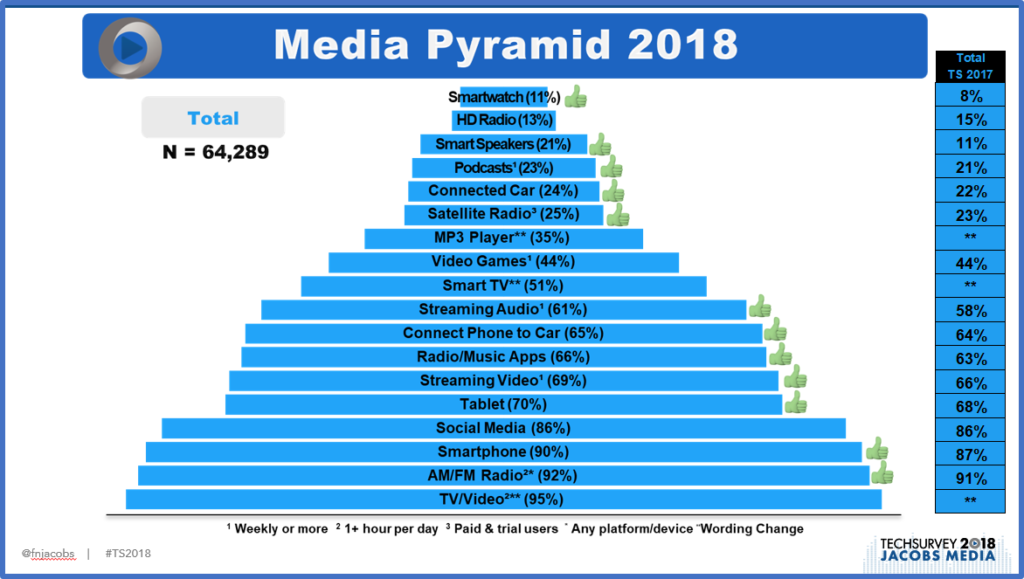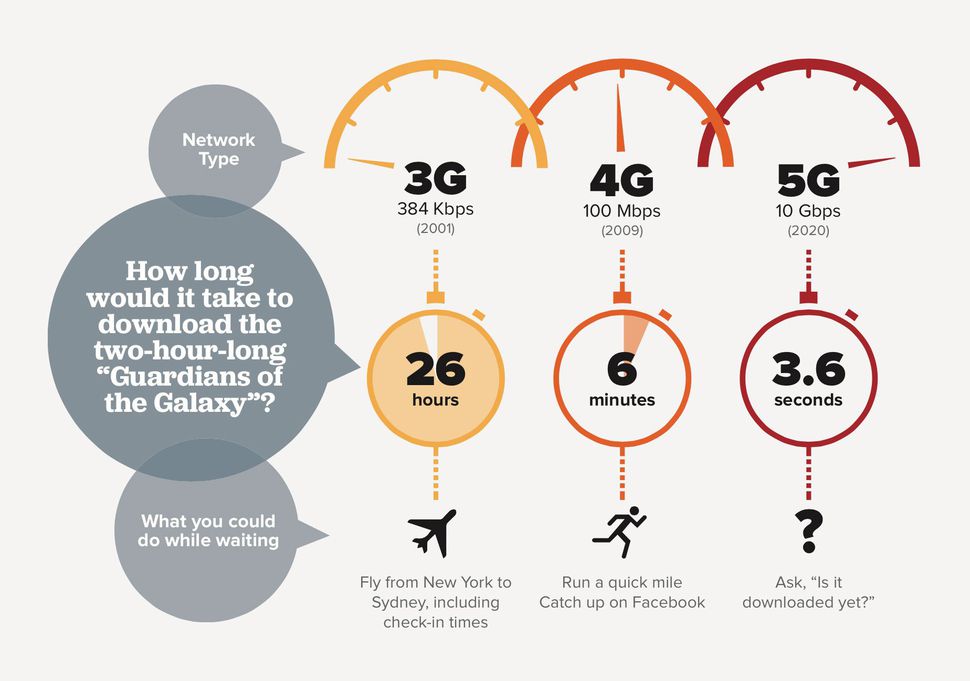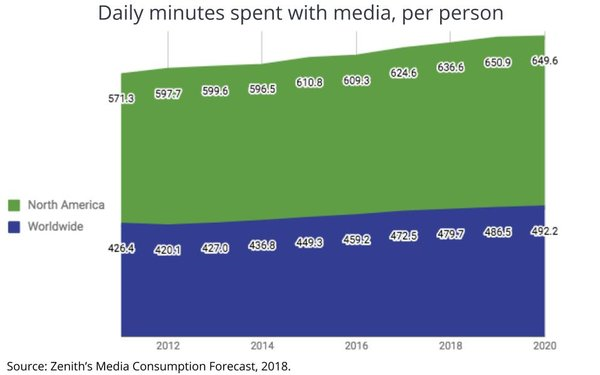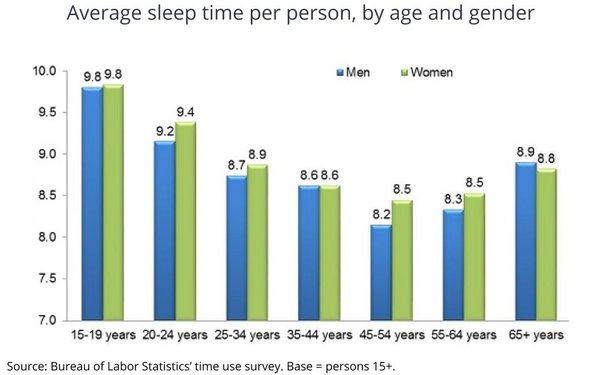
Consumers are inundated with media. Every year, new platforms, brands, gadgets, and technologies are introduced at shows like CES. Oftentimes, it doesn’t take long for them to reach the marketplace.
We’ve seen this in spades in our Techsurvey. Early on, we produced a single Media Usage Pyramid that graphically summarized core media consumption buckets like radio listening, TV viewing, streaming, and social media.
Today, that pyramid is doubled in size. And we’ve had to develop a second pyramid – the Brand Pyramid – that now contains well more than a dozen key brands encompassing audio and video streaming, social media, satellite radio, and of course, broadcast radio.
And amazingly, we see rising consumption numbers for so many platforms. The green “thumbs up” emojis you see on this year’s Media Usage Pyramid all represent notable increases in usage from just last year
Yes, weekly audio and video streaming have increased since last year. So has podcast listening. More of us are downloading music and radio-centric apps. And smart speaker ownership has nearly doubled.
Those are big headlines from this year’s Techsurvey. But perhaps the biggest takeaway from the Media Usage Pyramid is that almost everything is up year to year. (Some items show ** for last year’s totals, indicating a wording change – thus, no trending.)
What’s driving this? Well, clearly WiFi is becoming more ubiquitous. So are unlimited data plans. That facilitates a lot more use without the guilt of spending more money on technology.
But sheer speed plays a role, too. It’s hard to remember that smartphones just a decade ago ran on 3G. At the time, it seemed fast, but you may recall none of us watching videos on our iPhones. Then 4G came along, and it was a game-changer, enabling easier, seamless, and smooth streaming of just about anything.
Soon, 5G technology will be the new standard. As our radio CEOs learned during our CES tour this past January from tech maven Shawn DuBravac, the moves from 3G to 4G to 5G sound like incremental steps. And that’s misleading. In fact, they represent quantum leaps in speed and capacity, as you can see from the graphic below that illustrates how long it requires to download a two-hour movie using each of these technological improvements.

When consumers can download a two-hour movie during the time in which most stations do their top-of-the-hour legal IDs, that’s an eye-opener.
But isn’t there a limit to how much we can consume? After all, there are so many hours in a day.
It turns out our media consumption by day is growing and expected to increase even more in the coming years. In a story in Media Post, Zenith data indicates we will spend more than 636 minutes per day consuming media. And that’s projected to increase another 13 or so minutes in the next year or so. That’s quite a bit more than the worldwide average of spent using media.

Where and when will media consumption finally max out? After all, there’s only so many hours in a day.
The researchers at Zenith believe that sleep time is, in fact, the key variable that will determine when we stop consuming media. So, media consumption time will essentially hinge on awake time.
As Media Post points out, the U.S. Bureau of Labor Statistics reveals Americans non-sleeping day is 912 minutes – so as Jonathan Barnard, Zenith’s forecasting chieftain points out, “I think we have a way to go.”
Interestingly, younger people need more sleep than us Boomers, opening up even more media time for the generation that grew up with the Beatles, Stones, Zeppelin and the Who. Men also sleep less than women, a good sign for rock-formatted stations.

Obviously, the smartphone is the catalyst, the conduit, and the culprit – the device we carry everywhere (and even sleep with). As we learned in Techsurvey 2018, ownership of both smartphones and tablets continues to increase with each passing year. And mobile devices are the chief conduits for streaming, podcasts, and other media consumption.
It won’t be long before smart speakers make an even greater contribution to media consumption, as we’re already seeing across demographic groups, making it even easier to use our voices to call up the media we love and need.
For radio, this data is truly a double-edged sword. The good news, of course, is that media consumption continues to head north, making it even easier for Americans to enjoy our entertainment and information.
But the downside is that more time, more devices, more outlets, more platforms – more stuff – mean even more intense competition for the consumer’s time and attention – when they’re awake.
You have to be even better, more compelling, more relevant, more local, and more of something in order to stand out and get noticed in this overly abundant media-rich environment.
Back in April, we published Lori Lewis’ fascinating charts about what happens in an Internet minute. And as we noted at the time, most media consumption has increased from the previous year. Armed with this Zenith data, we now have more perspective.

For eons, we have studied TSL or Time Spent Listening data to better understand cume conversion and engagement with radio programming. But it turns out the new metric that might be more telling is TSS – or Time Spent Sleeping. Because as long as consumers are awake, we’ve got a shot at them.
Perhaps radio marketing will focus more on getting our audience out of bed and functioning. Instead of “Listen to Win,” we could start hearing “Wake Up & Win” and similar positioning statements.
So, how’s your station’s TSS?
- The Guy In The Next Car - May 6, 2025
- 5 Lessons For Radio From The Apple Watch - May 5, 2025
- DJs And Baristas: Can They Save Their Companies? - May 2, 2025




Hello Fred,
I hope all is well, I read your daily blogs via email. Its my hope you will do more analytics on Christian / Gospel Music genre. We sought of feel left out and have to apply your reporting accordingly.
Maybe we can discuss some of the problems and issues related to the genre.
Sincerely,
Henry W. Harris
Executive Director | EMA Administrator
T ▪ 301 567-5349 C ▪ 301 893-4451
[email protected] https://www.strategicmp.org
P.O. Box 1075, Oxon Hill, MD 20750
educate ▪ motivate ▪ recognize
Henry, we do a technology survey with Christian music radio stations every year. It goes into the field soon. If you’d like more information, don’t hesitate to contact me.